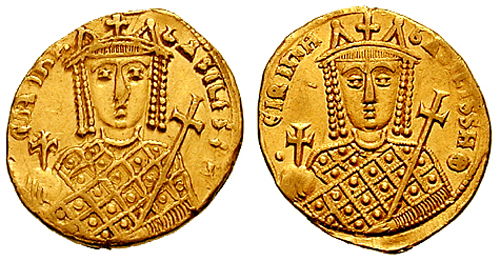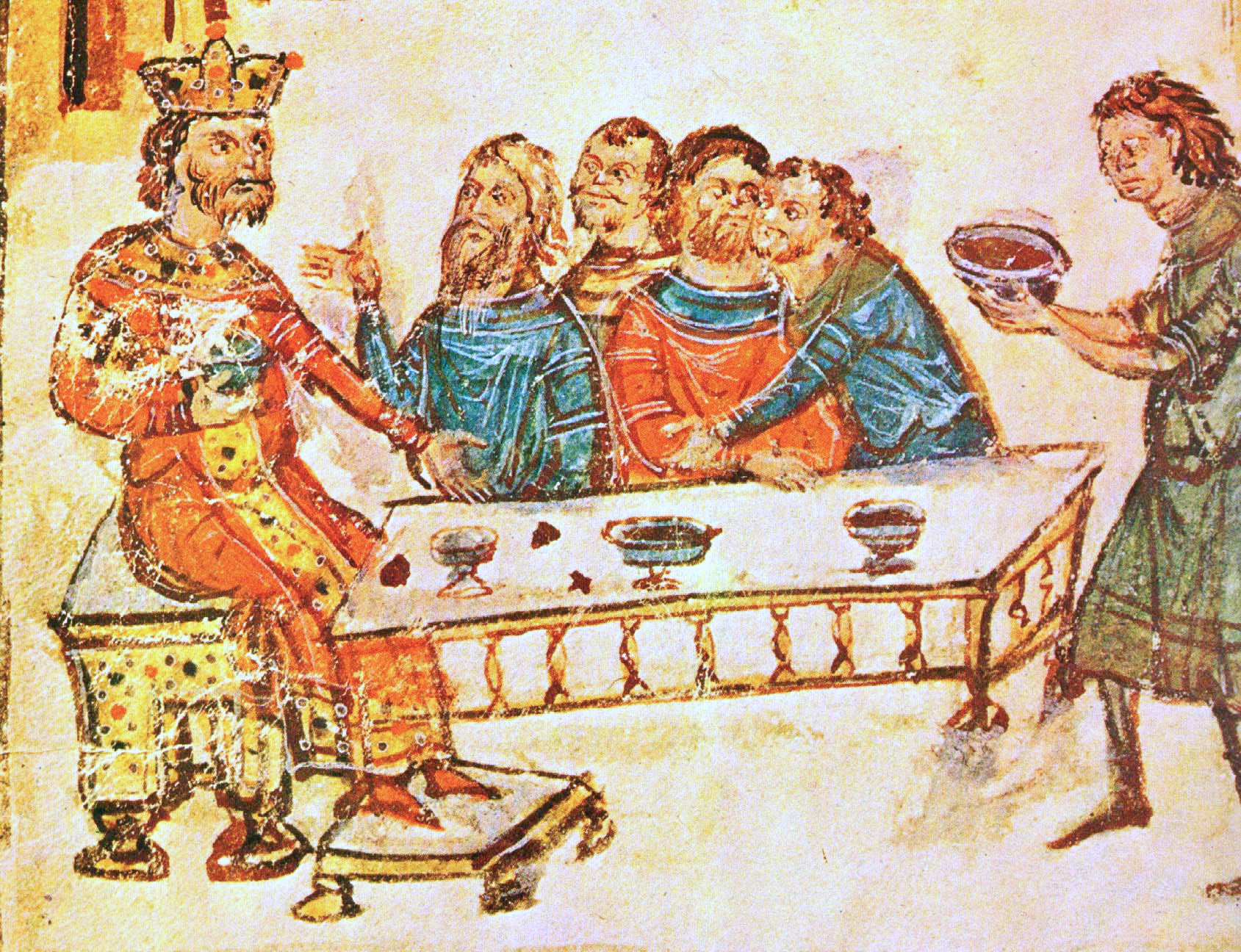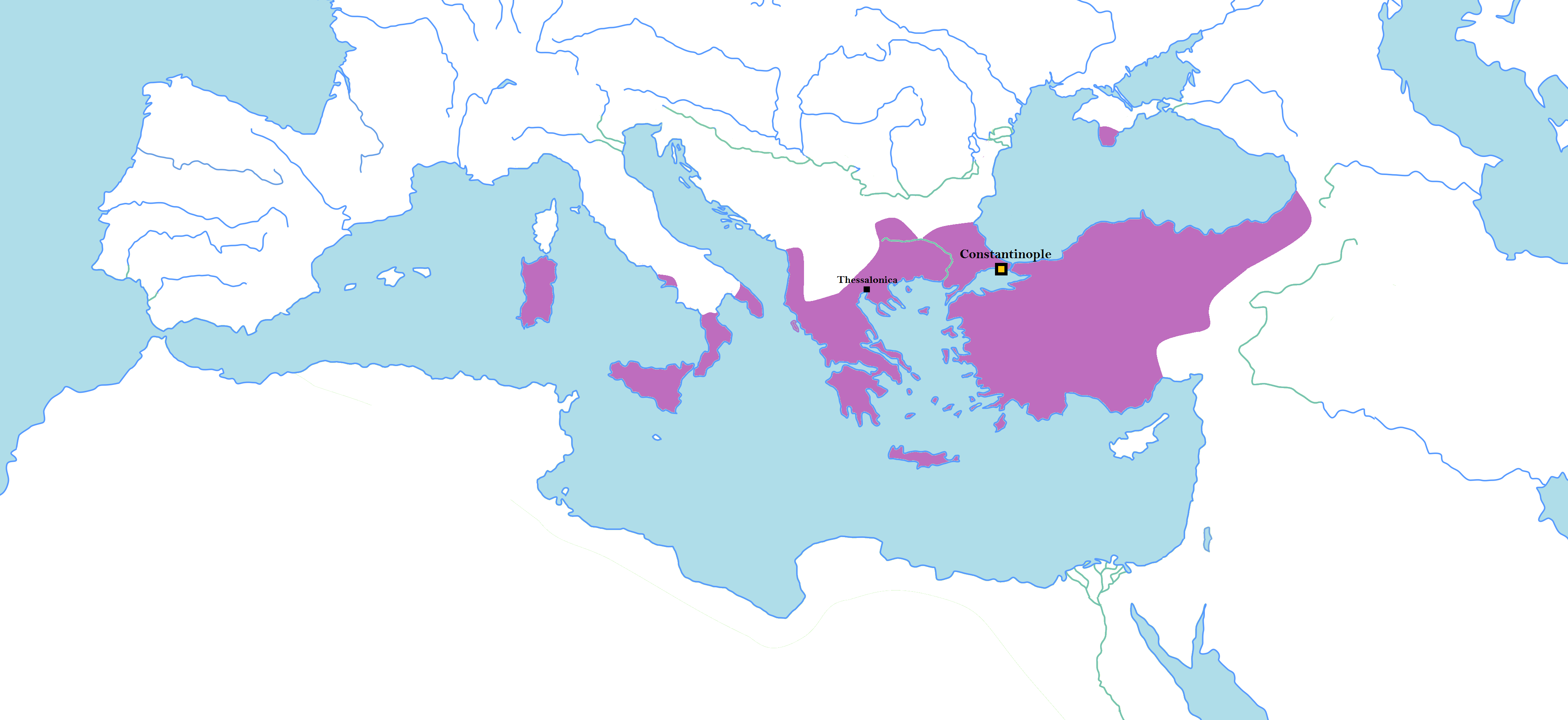|
803
__NOTOC__ Year 803 ( DCCCIII) was a common year starting on Sunday of the Julian calendar. Events By place Byzantine Empire * Emperors Nikephoros I and Charlemagne settle their imperial boundaries in the Adriatic Sea, and sign the Pax Nicephori ("Peace of Nikephoros"). The Byzantines retain control of the coastal cities and islands in Dalmatian Croatia, while Frankish rule is accepted over Istria and the Dalmatian hinterland. Venice is recognized as independent by the Byzantine Empire. * Summer – Bardanes Tourkos, Byzantine general (''strategos''), is proclaimed emperor by the troops of the Anatolic, Opsikion, Thracian and Bucellarian themes. The 'rebel' army marches to Chrysopolis, a suburb of Constantinople. After the defection of two of his trusted aides, future emperors Leo the Armenian and Michael the Amorian, Bardanes negotiates peace. Europe * May – Krum, ruler ( khan) of the Bulgarian Empire, begins his territorial expansion and raids th ... [...More Info...] [...Related Items...] OR: [Wikipedia] [Google] [Baidu] |
Bardanes Tourkos
Bardanes, nicknamed , "the Turk" (, ), was a Byzantine general who launched an unsuccessful rebellion against Emperor Nikephoros I () in 803. Although a major supporter of Byzantine empress Irene of Athens (), soon after her overthrow he was appointed by Nikephoros as commander-in-chief of the Anatolian armies. From this position, he launched a revolt in July 803, probably in opposition to Nikephoros's economic and religious policies. His troops marched towards Constantinople, but failed to win popular support. At this point, some of his major supporters deserted him and, reluctant to engage the loyalist forces in battle, Bardanes gave up and chose to surrender himself. He retired as a monk to a monastery he had founded. There he was blinded, possibly on Nikephoros's orders. Origin and early career Nothing is known of the early life of Bardanes, and his origin is disputed. On account of his first name—a Hellenized form of the common Armenian name Vardan—some scholars consi ... [...More Info...] [...Related Items...] OR: [Wikipedia] [Google] [Baidu] |
Pax Nicephori
''Pax Nicephori'', Latin for the "Peace of Nicephorus", is a term used to refer to both a peace treaty of 803, tentatively concluded between emperors Charlemagne, of the Frankish empire, and Nikephoros I, of the Byzantine Empire, and the outcome of negotiations that took place between the same parties, but were concluded by successor emperors, between 811 and 814. The whole set of negotiations of the years 802–815 has also been referred to by this name. By its terms, after several years of diplomatic exchanges, the Byzantine emperor's representatives recognized the authority in the West of Charlemagne, and East and West negotiated their boundaries in the Adriatic Sea. Failed negotiations of 803 On Christmas Day in 800 AD, Pope Leo III crowned Charlemagne as ''Imperator Romanorum'' (Latin for "Emperor of the Romans") in Saint Peter's Basilica. Nikephoros I of the Byzantine Empire and Charlemagne tried to settle their imperial boundaries in 803. A first treaty was indeed prepared ... [...More Info...] [...Related Items...] OR: [Wikipedia] [Google] [Baidu] |
First Bulgarian Empire
The First Bulgarian Empire (; was a medieval state that existed in Southeastern Europe between the 7th and 11th centuries AD. It was founded in 680–681 after part of the Bulgars, led by Asparuh of Bulgaria, Asparuh, moved south to the northeastern Balkans. There they secured Byzantine Empire, Byzantine recognition of their right to settle south of the Danube by Battle of Ongal, defeatingpossibly with the help of Seven Slavic tribes, local South Slavic tribesthe Byzantine army led by Constantine IV. During the 9th and 10th century, Bulgaria at the height of its power spread from the Danube Bend to the Black Sea and from the Dnieper River to the Adriatic Sea and became an important power in the region competing with the Byzantine Empire. As the state solidified its position in the Balkans, it entered into a centuries-long interaction, sometimes friendly and sometimes hostile, with the Byzantine Empire. Bulgaria emerged as Byzantium's chief antagonist to its north, resulting in ... [...More Info...] [...Related Items...] OR: [Wikipedia] [Google] [Baidu] |
Krum
Krum (, ), often referred to as Krum the Fearsome () was the Khan of Bulgaria from sometime between 796 and 803 until his death in 814. During his reign the Bulgarian territory doubled in size, spreading from the middle Danube to the Dnieper and from Odrin to the Tatra Mountains. His able and energetic rule brought law and order to Bulgaria and developed the rudiments of state organization. Biography Origins Krum was a Bulgar chieftain from Pannonia. His family background and the surroundings of his accession are unknown. It has been speculated that Krum might have been a descendant of Khan Kubrat through his son Kuber. The Bulgar name Krum comes from the Old Turkic ''qurum'' and means "ruler". Establishment of new borders Around 805, Krum defeated the Avar Khaganate to destroy the remainder of the Avars and to restore Bulgar authority in Ongal again, the traditional Bulgar name for the area north of the Danube across the Carpathians covering Transylvania and along t ... [...More Info...] [...Related Items...] OR: [Wikipedia] [Google] [Baidu] |
Nikephoros I
Nikephoros I (; 750 – 26 July 811), also known as Nicephorus I, was Byzantine emperor from 802 to 811. He was General Logothete (finance minister) under Empress Irene, but later overthrew her to seize the throne for himself. Prior to becoming emperor, he was sometimes referred to as "the Logothete" () and "Genikos" or "Genicus" (), in recognition of his previous role as General Logothete. During his reign, Nikephoros engaged in military campaigns against both the Arabs and the Bulgarians, although the outcomes were varied. While leading an invasion into Bulgaria, he suffered a defeat and was killed at the Battle of Pliska. Background According to several sources outside the Byzantine context, such as Michael the Syrian, al-Tabari, and Mas'udi, there is a tradition that suggests Nikephoros had Ghassanid Arab origins and that he descended from the final Ghassanid ruler Jabala ibn al-Ayham. Al-Tabari assets that he obtained this information from Byzantine sources, althou ... [...More Info...] [...Related Items...] OR: [Wikipedia] [Google] [Baidu] |
Transylvania
Transylvania ( or ; ; or ; Transylvanian Saxon dialect, Transylvanian Saxon: ''Siweberjen'') is a List of historical regions of Central Europe, historical and cultural region in Central Europe, encompassing central Romania. To the east and south its natural border are the Carpathian Mountains and to the west the Apuseni Mountains. Broader definitions of Transylvania also include the western and northwestern Romanian regions of Crișana and Maramureș, and occasionally Banat. Historical Transylvania also includes small parts of neighbouring Western Moldavia and even a small part of south-western neighbouring Bukovina to its north east (represented by Suceava County). Transylvania is known for the scenery of its Carpathian landscape and its rich history, coupled with its multi-cultural character. It also contains Romania's second-largest city, Cluj-Napoca, and other very well preserved medieval iconic cities and towns such as Brașov, Sibiu, Târgu Mureș, Bistrița, Alba Iuli ... [...More Info...] [...Related Items...] OR: [Wikipedia] [Google] [Baidu] |
Anatolic Theme
The Anatolic Theme (, ''Anatolikon hema'), more properly known as the Theme of the Anatolics (Greek: , ''thema Anatolikōn''), was a Byzantine theme (a military-civilian province) in central Asia Minor (modern Turkey). From its establishment, it was the largest and senior-most of the themes, and its military governors ('' stratēgoi'') were powerful individuals, several of them rising to the imperial throne or launching failed rebellions to capture it. The theme and its army played an important role in the Arab–Byzantine wars of the 7th–10th centuries, after which it enjoyed a period of relative peace that lasted until its conquest by the Seljuk Turks in the late 1070s. Geography and administration In its "classical" form during the 8th and 9th centuries, the theme stretched over the ancient regions of Lycaonia, Pisidia, Isauria, as well as most of Phrygia and parts of Galatia Salutaris.. Initially, the Anatolic Theme included the western and southern shores of Asia Minor as ... [...More Info...] [...Related Items...] OR: [Wikipedia] [Google] [Baidu] |
Venice
Venice ( ; ; , formerly ) is a city in northeastern Italy and the capital of the Veneto Regions of Italy, region. It is built on a group of 118 islands that are separated by expanses of open water and by canals; portions of the city are linked by 438 bridges. The islands are in the shallow Venetian Lagoon, an enclosed bay lying between the mouths of the Po River, Po and the Piave River, Piave rivers (more exactly between the Brenta (river), Brenta and the Sile (river), Sile). As of 2025, 249,466 people resided in greater Venice or the Comune of Venice, of whom about 51,000 live in the historical island city of Venice (''centro storico'') and the rest on the mainland (''terraferma''). Together with the cities of Padua, Italy, Padua and Treviso, Italy, Treviso, Venice is included in the Padua-Treviso-Venice Metropolitan Area (PATREVE), which is considered a statistical metropolitan area, with a total population of 2.6 million. The name is derived from the ancient Adr ... [...More Info...] [...Related Items...] OR: [Wikipedia] [Google] [Baidu] |
Dalmatian Croatia
The Duchy of Croatia (Modern ; also Duchy of the Croats, Modern ; ; ) was a medieval state that was established by White Croats who migrated into the area of the former Roman province of Dalmatia 7th century AD. Throughout its existence the Duchy had several seats – namely, Klis, Solin, Knin, Bijaći and Nin. It comprised the ''littoral –'' the coastal part of today's Croatia ''–'' except Istria, and included a large part of the mountainous hinterland as well. The Croats settled in Dalmatia after defeating the Pannonian Avars, during the time of Byzantine emperor Heraclius I. The Duchy was in the center of competition between the Byzantine Empire and the Carolingian Empire for rule over the area. Croatian rivalry with Venice emerged in the first decades of the 9th century and would continue through the following centuries. Croatia also waged battles with the Bulgarian Empire (founded ; Bulgar-Croatian relations improved greatly afterwards) and with the Arabs; it also sou ... [...More Info...] [...Related Items...] OR: [Wikipedia] [Google] [Baidu] |
Adriatic Sea
The Adriatic Sea () is a body of water separating the Italian Peninsula from the Balkans, Balkan Peninsula. The Adriatic is the northernmost arm of the Mediterranean Sea, extending from the Strait of Otranto (where it connects to the Ionian Sea) to the northwest and the Po Valley. The countries with coasts on the Adriatic are Albania, Bosnia and Herzegovina, Croatia, Italy, Montenegro, and Slovenia. The Adriatic contains more than 1,300 islands, mostly located along its eastern coast. It is divided into three basins, the northern being the shallowest and the southern being the deepest, with a maximum depth of . The prevailing currents flow counterclockwise from the Strait of Otranto. Tidal movements in the Adriatic are slight, although acqua alta, larger amplitudes occur occasionally. The Adriatic's salinity is lower than the Mediterranean's because it collects a third of the fresh water flowing into the Mediterranean, acting as a dilution basin. The surface water temperatures ... [...More Info...] [...Related Items...] OR: [Wikipedia] [Google] [Baidu] |
Danube
The Danube ( ; see also #Names and etymology, other names) is the List of rivers of Europe#Longest rivers, second-longest river in Europe, after the Volga in Russia. It flows through Central and Southeastern Europe, from the Black Forest south into the Black Sea. A large and historically important river, it was once a frontier of the Roman Empire. In the 21st century, it connects ten European countries, running through their territories or marking a border. Originating in Germany, the Danube flows southeast for , passing through or bordering Austria, Slovakia, Hungary, Croatia, Serbia, Romania, Bulgaria, Moldova, and Ukraine. Among the many List of cities and towns on the river Danube, cities on the river are four national capitals: Vienna, Bratislava, Budapest, and Belgrade. Its drainage basin amounts to and extends into nine more countries. The Danube's longest headstream, the Breg (river), Breg, rises in Furtwangen im Schwarzwald, while the river carries its name from its ... [...More Info...] [...Related Items...] OR: [Wikipedia] [Google] [Baidu] |
Istria
Istria ( ; Croatian language, Croatian and Slovene language, Slovene: ; Italian language, Italian and Venetian language, Venetian: ; ; Istro-Romanian language, Istro-Romanian: ; ; ) is the largest peninsula within the Adriatic Sea. Located at the top of the Adriatic between the Gulf of Trieste and the Kvarner Gulf, the peninsula is shared by three countries: Croatia, Slovenia, and Italy,Marcel Cornis-Pope, John Neubauer''History of the literary cultures of East-Central Europe: junctures and disjunctures in the 19th And 20th Centuries'' John Benjamins Publishing Co. (2006), Alan John Day, Roger East, Richard Thomas''A political and economic dictionary of Eastern Europe'' Routledge, 1sr ed. (2002), 90% of its area being part of Croatia. Most of Croatian Istria is part of Istria County. Geography The geographical features of Istria include the Učka/Monte Maggiore mountain range, which is the highest portion of the Ćićarija/Cicceria mountain range; the rivers Dragonja/Dragogna, ... [...More Info...] [...Related Items...] OR: [Wikipedia] [Google] [Baidu] |







